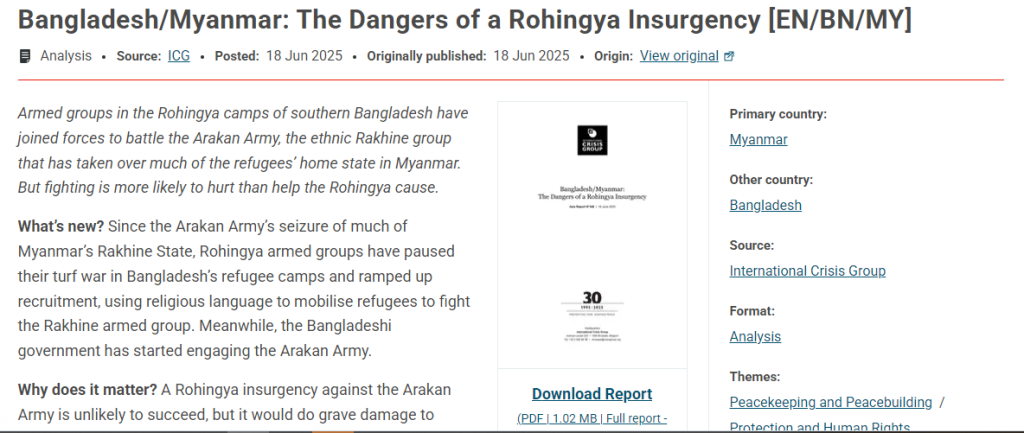By Madara Dias, MHR Program, University of Manitoba
Date: June 22, 2025
In a troubling turn of events for one of the world’s most protracted refugee crises, a new wave of instability is gathering along the Bangladesh-Myanmar border. A June 2025 report by the International Crisis Group (ICG) warns that a growing alliance of Rohingya armed groups, long marginalized and splintered, is beginning to coalesce around the idea of launching an insurgency against the Arakan Army (AA) in Myanmar’s Rakhine State. If allowed to escalate, this could devastate already fragile intercommunal relations, delay repatriation for nearly one million Rohingya refugees, and destabilize the region.
This blog unpacks the report’s key findings and what they mean for policymakers, aid workers, and the broader international community.
The Shift: From Camps to Combat
For years, the sprawling refugee camps in Bangladesh’s Cox’s Bazar were marked by hardship and despair, but not organized militancy. Armed Rohingya groups like ARSA (Arakan Rohingya Salvation Army) and the RSO (Rohingya Solidarity Organisation) had largely been engaged in turf wars rather than united political goals. But since late 2024, that has changed.
Following the Arakan Army’s military takeover of northern Rakhine, once home to most of Myanmar’s Rohingya population which is armed Rohingya groups declared a truce among themselves and refocused their efforts on confronting the AA. This pivot came as the Rohingya became increasingly disillusioned, not only with the Myanmar military that had brutalized them in 2017, but also with the Arakan Army, now accused of attacks and human rights violations against Rohingya civilians.
What’s most concerning is the shift in recruitment strategy. Instead of relying on coercion alone, armed groups are leveraging religious narratives and framing their struggle as a “jihad” against “non-believers” and holding mass rallies inside the camps. These efforts, sometimes openly tolerated by Bangladeshi security forces, have significantly boosted their ranks.
The Risk: A Dangerous Gamble
While these armed groups may not yet have the capacity for a sustained insurgency, the idea is taking hold. Thousands of young Rohingya men, specially some with encouragement from family and community leaders have begun training in border camps. The support is not unanimous, but the despair is widespread. Refugees see few alternatives. With education and work opportunities dwindling and repatriation nowhere in sight, armed struggle increasingly feels like the only option.
Bangladesh’s interim government, led by Nobel laureate Muhammad Yunus, appears to be walking a fine line. On one hand, it has taken steps to open dialogue with the Arakan Army, which now controls the entire Myanmar border. On the other, its intelligence agencies are suspected of backing or at least tolerating Rohingya armed groups as leverage on either to pressure the Arakan Army into accepting repatriation, or to carve out a future “safe zone” for the Rohingya inside Myanmar.
Either way, the stakes are high. Any insurgency would risk dragging Bangladesh into renewed conflict and could shatter the fragile trust needed for meaningful repatriation talks.
Victims Again: The Rohingya Caught in the Middle
Perhaps the most heartbreaking consequence of a new insurgency is the danger it poses to the Rohingya themselves. Those still inside Myanmar, estimated at around 400,000 are increasingly at risk of being caught between warring factions. In towns like Buthidaung and Maungdaw, attacks by Rohingya fighters have already triggered retaliatory “clearance operations” by the Arakan Army, displacing thousands and destroying entire villages.
Meanwhile, in Cox’s Bazar, armed group dominance is eroding what little civilian leadership the camps once had. Women, in particular, face greater restrictions, intimidation, and gender-based violence. Religious leaders and Madrassa teachers are being co-opted into recruitment drives, while humanitarian workers report rising fear among families and local leaders who oppose militarization but feel powerless to resist.
Even within the camps, the new unity among armed groups is fragile. It was brokered by controversial figures with ties to Myanmar’s military and lacks long-term trust. If this fragile coalition collapses, inter-group violence may return with even more intensity.
A Crisis Worsened by Aid Cuts
A perfect storm of funding cuts has added fuel to the fire. With the return of Donald Trump to the U.S. presidency in early 2025, American aid, which previously accounted for more than half of the refugee response budget has plummeted. Programs for food, education, and health care have been slashed. Local jobs created by aid agencies have disappeared. The U.S. has also shut down all refugee resettlement programs, including plans to take in 20,000 Rohingya annually.
This sudden vacuum is pushing many young people toward the only groups promising money and purpose of the armed militias. Others are fleeing altogether by risking their lives on overcrowded boats to Malaysia and Indonesia, with dozens reportedly drowning in recent weeks.
The human cost of these aid cuts is staggering, but the long-term political cost may be even worse. Desperation breeds radicalization. Every cut, every closed clinic or empty classroom, becomes one more reason to give up on peaceful solutions.
What Can Be Done?
The International Crisis Group report offers a sobering but constructive roadmap:
- Bangladesh must crack down on the
growing influence of armed groups in the camps and invest in civil
society-led leadership among the refugees. Its dialogue with the Arakan
Army should be deepened, not undermined.
- The
Arakan Army
must begin demonstrating inclusive governance by protecting all
communities in Rakhine, specially Rohingya community and engaging in
good-faith talks with their representatives.
- Donors, especially those outside the
U.S., must urgently step in to stabilize aid flows and prevent further
deterioration. Targeted investments in education, housing, and livelihood
programs can help reduce the appeal of armed groups.
Time is running out. The emergence of a Rohingya insurgency may seem unlikely to succeed militarily, but its humanitarian and diplomatic consequences could be profound. Instead of solving the refugee crisis, it risks turning Cox’s Bazar into a launching pad for endless conflict and making return to Myanmar even more difficult, if not impossible.
Final Thoughts
The international community’s attention has drifted from the Rohingya crisis. But the ICG report is a stark reminder where unresolved injustice rarely lies dormant. When hope is starved, extremism finds a way to grow.
To avoid yet another cycle of bloodshed, stakeholders from Dhaka to Brussels to Washington must act swiftly and decisively. The world may not be able to erase the Rohingya’s suffering, but it can prevent the next chapter from being written in gunfire and grief.
Sources:
International Crisis Group, Asia Report No. 348 – Bangladesh/Myanmar: The Dangers of a Rohingya Insurgency, 18 June 2025.
- Bangladesh must crack down on the
growing influence of armed groups in the camps and invest in civil
society-led leadership among the refugees. Its dialogue with the Arakan
Army should be deepened, not undermined.



